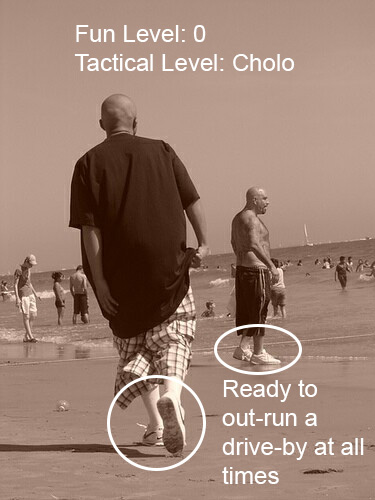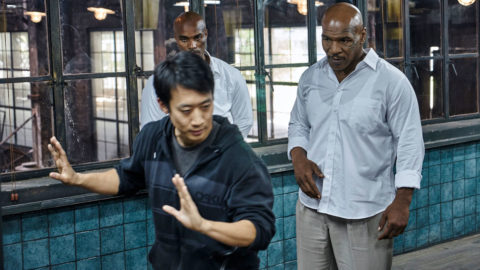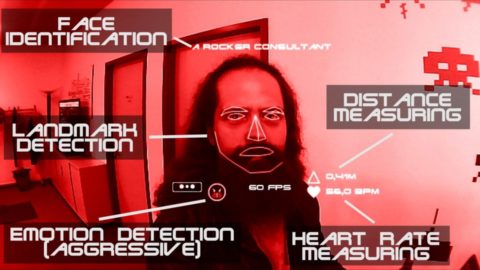Self-Defense, Flip-Flops, & Hypocrisy
Nathan Wagar
I’m from California originally, and one of the hardest habits I’ve had to break as a self-defense instructor is to stop wearing flip-flops at night. This seems like a no-brainer and it should be, but it highlights how differently risk analysis works in our day-to-day lives, even for people that should know better.
California was a different mentality from New Mexico. Flip-flops, beaches and board shorts were a way of life in Los Angeles, and the home-state pride made it so even when it was Winter in New Mexico, I refused to step out of my flip-flops because it was a full-blown issue of identity. Seeing how cold my feet could get before I bitched out became an actual game I would play with myself.
Part of this was no doubt because Cali had things like “grass” and didn’t have things like “goat heads” to worry about stepping on. Warm concrete, soft grass, and cool water feel nice on the feet, vs the nightmare awaiting you if your foot slips out and hits the ground out here in the land of enchantment.

But the problem comes when I let my mind remember the good times but not the bad. I lived in a rough neighborhood, and people paid attention to their footwear because you never knew when something popped off. You were able to relax a little bit because nobody went places alone; you always had friends with you as backup. This isn’t much different than when ladies wear more sensible footwear when they are by themselves, and only bust out with the stiletto heels when they have their husbands with them or are in a larger group.
We all make small decisions like this, where we intuitively know how much backup or “control” we have over a situation, and compensate accordingly. Most of my job teaching real-world self-defense involves much less about teaching hand-to-hand fighting skills, and much more about balancing the sliding scale of control to fit the situation. The problem is that people are inconsistent, even when they think they know the risk. When enough quiet nights pass with no consequences even though they did the wrong thing, this inconsistency can lead them to change their view of risk itself.
I’ll give an example. I’ve always been a night owl, and sleep issues from the war only made it more true over time. This means lots of late-night dashes to Walmart because I need tomatillos or forgot some ingredient for stew. Nobody really bothers me, I like wearing flip-flops, and this means that in my infinite laziness when I need to get something from the store, I have just gone in flip-flops. Nothing has ever happened, and nothing probably ever will happen.
Probably.
But this article isn’t really about statistics, perception, or probability. This is more about the fact that human beings respond to tangible things, and we have a harder time living our lives according to rules, abstract codes of ethics, and potentials. Even more amusingly, we still often do the wrong thing and ignore simple rules even when we have seen the consequences to our actions.
When I was in the Army, we faced certain kidnapping and/or death if we were caught sleeping on guard, but op tempos were so high that a sleeping, exhausted guard was a constant worry. We were in one of the worst AO’s in Iraq, and our lives depended on clean weapons, and yet NCO’s did, and will have to deal, with dirty little privates and their dirty little weapons until the earth crashes into the sun. We should have known better, and we did. But it didn’t matter, because we were human.
Until you have faced violence in flip-flops, it doesn’t really hammer home to you how utterly useless you are. Fighting on city concrete barefoot hurts a lot afterwards. You can also really mess up your toes, and it’s hard to move fast enough to deal with someone drawing or using a weapon, or trying to break into your car. I have been in encounters in flip-flops before. And yet every night I struggle not to go to the grocery store in flip-flops.

People often hem and haw and point fingers when an instructor writes an article like this; that’s not to try and act as though I am doing anything dramatic, it’s just how it is. The internet and the various tactical forums are full of examples. The reality of the self-defense instructor world is that we are full of shit 9.9 times out of 10. We don’t practice what we preach because we don’t have multiple layers of a chain of command over us like the military does, making sure we don’t mess up.
We calculate our own risk, view it through the lenses of laziness and comfort, and most of us are living decent lives and are in no immediate risk of having our mistakes brutally punished by outside forces.
Just like military commanders and rival service-members go apeshit when privates talk matter-of-factly about people sleeping on guard as though it never happens in their unit, I am saying matter-of-factly that most self-defense instructors are utterly full of shit when it comes to practicing what they preach. I say this speaking for myself, as well as many of your treasured instructors that I have worked and maintained friendships with long after our clients leave the course.
That doesn’t mean that you shouldn’t learn from them, because everyone on the planet is full of shit when it comes to practicing what they preach. It also doesn’t mean they don’t have legitimate experiences, because I’ve already shown how that doesn’t matter.
What it does mean, however, is that just as I have slowly forced myself to do even when I know nothing will probably happen…when it’s late and you are going to Walmart? You should put on some shoes.
One of the most amusing things in the world to me is that people really seem to believe that their knowledge by itself is enough to change their behavior. Aristotle knew better. What reliably determines behavior in the future is enough of the desired behavior in the past. That’s it. Habit.
Self-defense is about having good habits, and habits take effort even when you think they don’t matter in the moment. It isn’t about training for an event; it’s about having a successful base for dealing with people. If you’re too lazy to put on some running shoes when you know you should, you’re probably failing in a few other places as well. I say that out of love, and quite a bit of experience.










 Rob Brotzman
Rob Brotzman  Nathan Wagar
Nathan Wagar